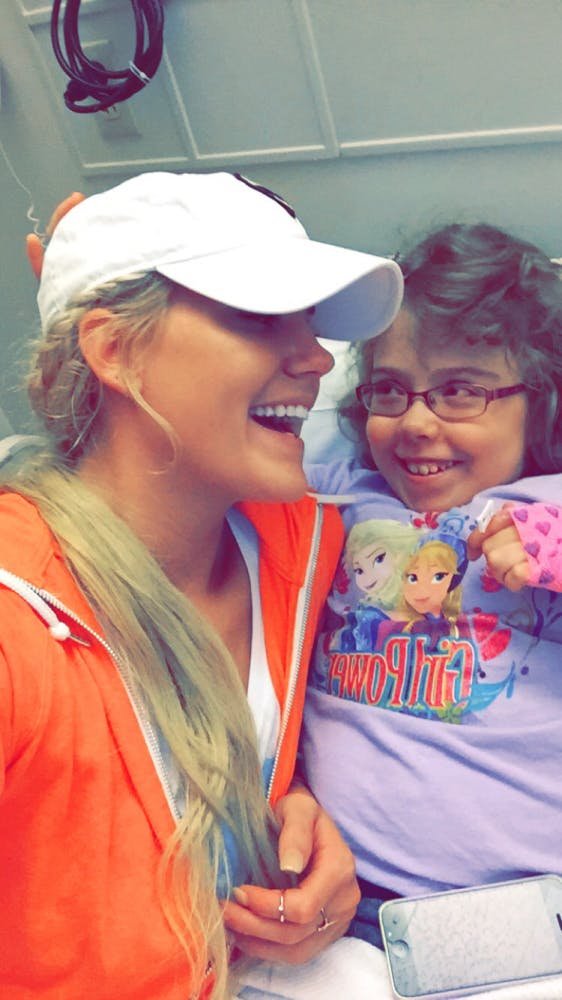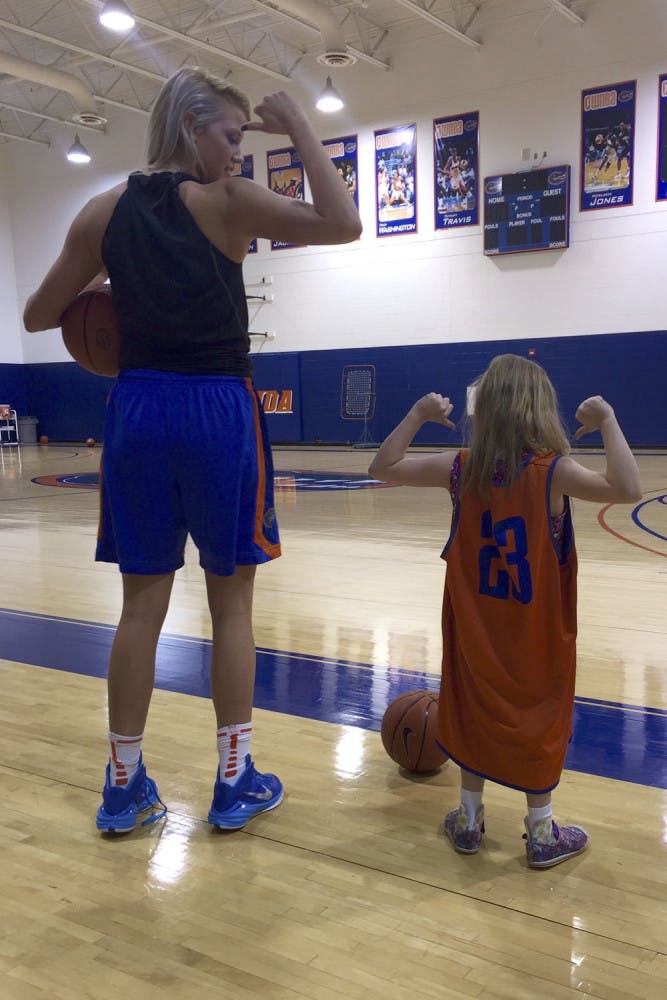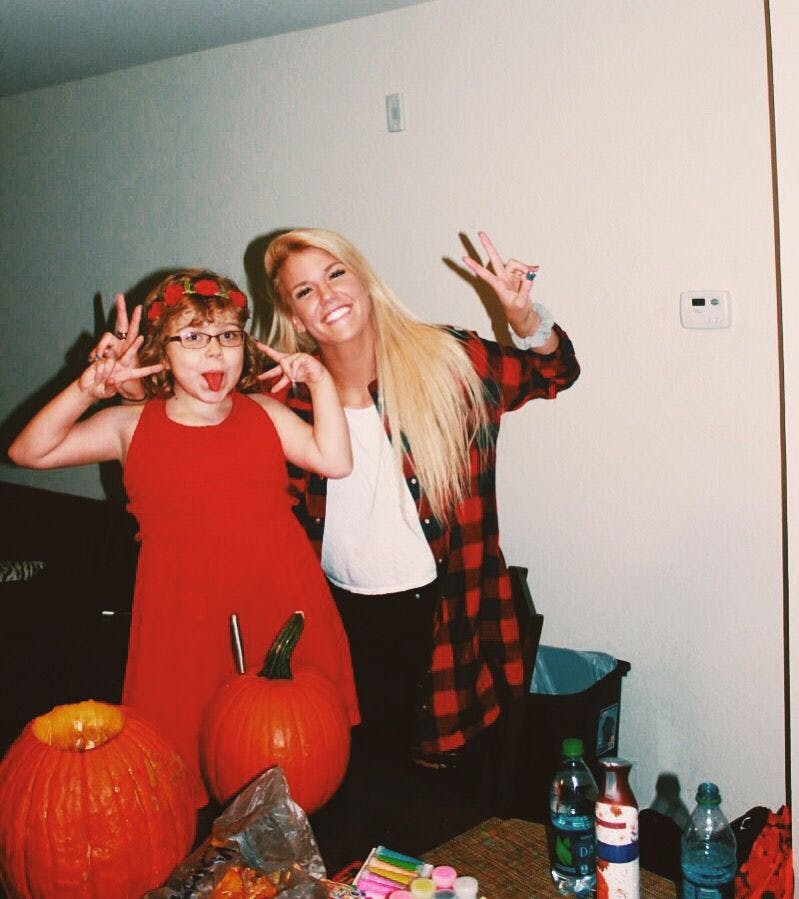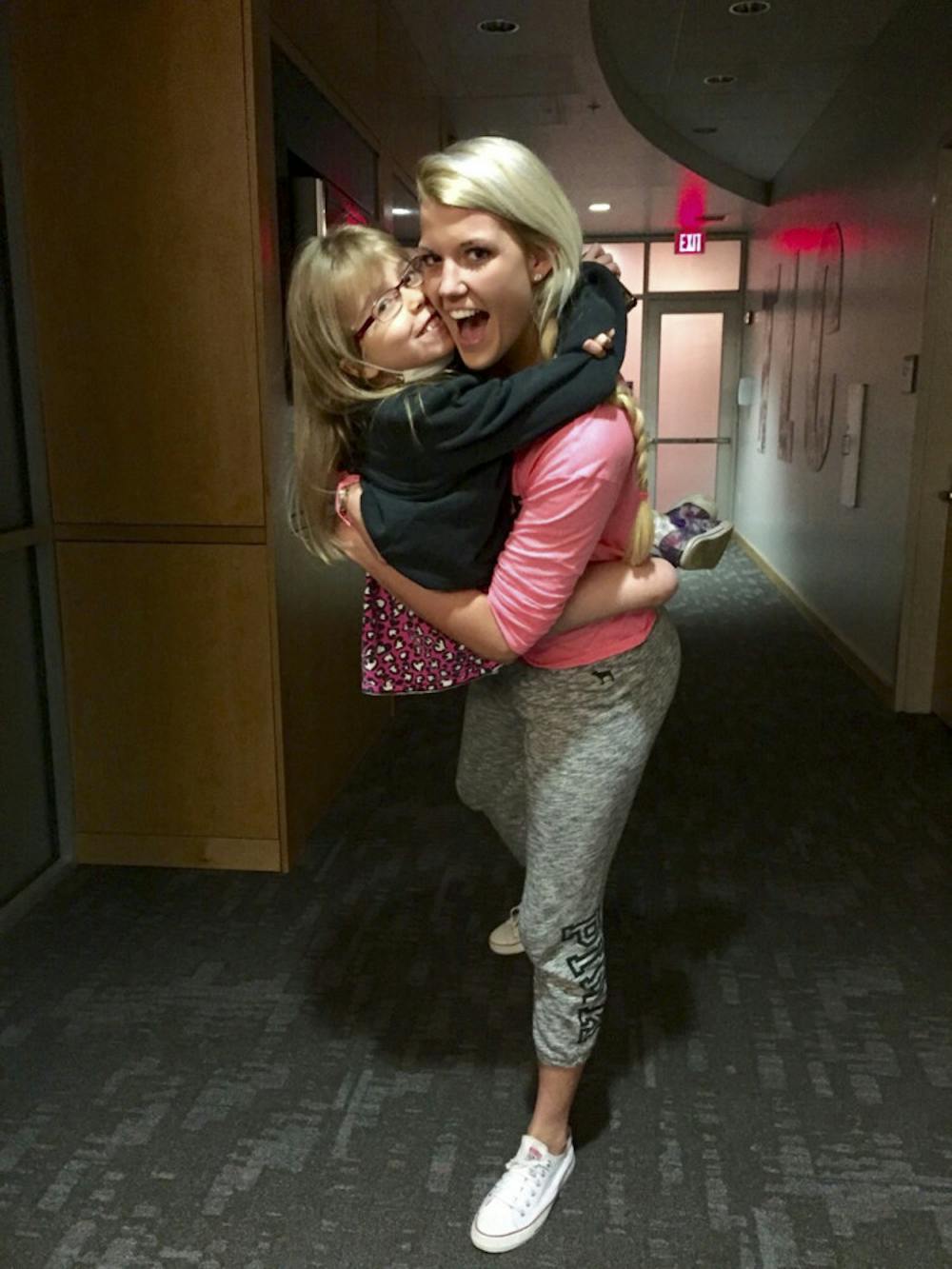Brooke Copeland always believed in divine intervention.
From birth, the Cleveland, Tennessee, native was brought up as a Baptist in the “buckle of the Bible Belt.”
That’s why she was baptised in the Jordan River — the site of Jesus Christ’s baptism — as a high school freshman. That’s why she came to Florida to play basketball. And that’s why she walked into a hospital room at UF Health Shands Hospital on a December day in 2014.
God’s path brought her to AnnaRose Van Sciver, a then-10-year-old struggling to overcome cancer.
Over the course of the next 13 months, the two shared a bond that would last through sickness and sweetness, cancer and dance parties, uncertainty and elation.
Through it all, the sophomore never doubted her place in AnnaRose’s life, or AnnaRose’s place in hers.
“I know it was definitely a God thing that brought me to her,” Brooke said. “Knowing that I needed her and that she needed me as well.”
• • •
AnnaRose wasn’t the first patient Brooke befriended.
Even before she began making weekly visits to Shands as a UF freshman, Brooke was drawn toward people who needed a friend.
Now a 20-year-old UF telecommunication student, she said her passion for reaching out to others stems from a childhood spent with her aunt Lynette, who has Down syndrome.
She watched as other children mocked her aunt because of her appearance.
“I would never viciously attack anyone because of her treatment,” Brooke said of her aunt being ridiculed. “Although I wanted to.”
While her anger did make her lash out verbally at a few, her sympathy made her empathetic toward many.
As early as kindergarten, she remembers making an effort to sit with her classmates who were lonely.
That compassion for the people around her stayed with Brooke throughout her life.
“It brings me joy to know that they’re not alone,” she said.
Brooke’s status as a basketball player at UF has put her in a unique position to impact those around her. From her weekly visits to Shands to her work with Girl’s Place, Inc., a Gainesville after-school program, she embraces the opportunity to go beyond the team’s community service initiatives.
According to head coach Amanda Butler, Brooke is the leader of the team when it comes to community involvement.
“She gives a lot of her time away, but for her, she doesn’t think of it as giving,” Butler said. “It’s something that she gets back.”
It was a team visit that brought Brooke to the Shands pediatric ward in late December 2014.
But it was her commitment to others that led to a connection with AnnaRose.
And it was their friendship that kept Brooke coming back.
• • •

Hours after she was born, AnnaRose stopped breathing.
There was no preparation for this moment. Every sonogram and doctor’s appointment showed Cean and Jim Van Sciver that their first child would be born healthy.
But two hours after her birth on May 5, 2004, AnnaRose turned blue.
The 5-pound newborn was given oxygen and was able to breathe again, but the doctors at Millard Fillmore Suburban Hospital in upstate New York weren’t equipped to help beyond childbirth.
Cean didn’t get to hold her daughter before she sped away in an ambulance to a hospital in Buffalo.
A cardiologist examined her heart more thoroughly and determined that AnnaRose’s breathing difficulty came from two rare heart defects: hypoplastic left heart syndrome and double outlet right ventricle.
The first meant the left side of her heart was severely underdeveloped. The second meant blood flowed from only one side of her heart instead of from two.
The defects were treatable, but AnnaRose’s doctors feared she wouldn’t make it through surgery.
The day after she was born, a priest blessed her life-to-come in a baptismal ceremony. He then blessed her in preparation for death.
Two weeks after the defects were identified, AnnaRose had her first open-heart surgery.
It wouldn’t be her last.
Over the next five years, AnnaRose would undergo three surgeries. The last, a Fontan procedure, was supposed to be a relatively long-term solution.
“We have patients that, depending on a lot of other factors, the Fontan has worked for a long time,” said Jay Fricker, AnnaRose’s doctor at UF Health’s Congenital Heart Institute.
While the procedure successfully enabled her one working main artery to do the work of two, AnnaRose was still constantly sick.
She often had pneumonia and bronchitis, eventually developing a rare condition called plastic bronchitis as a direct result of the Fontan procedure.
Because they weren’t familiar with the sickness, her doctors in Buffalo couldn’t treat her anymore.
All they could determine was that AnnaRose was healthier during the summer months. Running out of options — and potentially out of time — the Van Scivers moved to the year-round warmth of Kissimmee, Florida, in 2011.
They left AnnaRose’s grandparents, cousins and aunt behind.
“It was very difficult,” Cean said. “She misses being with her family.”
Despite the heat, a new series of problems surfaced: stomach issues, bouts with anxiety and more heart complications.
Shortly before Christmas 2012, her doctors at the Arnold Palmer Hospital for Children in Orlando referred AnnaRose to Shands to be evaluated for a transplant.
It was a last resort for her parents.
“We were pushing it back and thought no, she doesn’t really need a transplant, because she was healthy most of the time,” Cean said.
But the doctors at Shands confirmed the family’s fears: Her Fontan procedure was failing. With that diagnosis, AnnaRose was finally put on the transplant list in March 2013.
In June, she started to complain of stomach pains, saying that these were different than the ones she’d been having.
Her parents rushed her to the emergency room. AnnaRose was already vomiting.
When she arrived at the hospital, doctors discovered she had gone into heart failure.
She lived at the hospital for the next nine months and waited for a transplant. As the waiting wore on, she became so sick that she could barely walk and was rarely awake.
Almost a year after being added to the registry, AnnaRose received the heart she had needed since the day she was born.
But with that solution came a new problem.
Nine months after the transplant, doctors realized the side effects of Prograf, the drug AnnaRose had taken since she received the transplant in order to help her body accept the new organ.
In purposely suppressing her immune system, the drugs had paved the way for the development of post-transplant lymphoproliferative disease.
Armed with a functioning heart, the 10-year-old would now battle cancer.
On a day in late December 2014, AnnaRose found out that the cancer was malignant and would require chemotherapy.
On that same day, she met Brooke Copeland.
• • •

When Brooke walked into the room, AnnaRose didn’t see a basketball player.
She saw a princess.
With a single blonde braid down to her waist, Brooke reminded AnnaRose of Elsa, a princess from the movie “Frozen.”
Greeted with “Elsa,” Brooke played along, calling AnnaRose Anna, after Elsa’s younger sister.
The fictional sisterhood would serve as the foundation for their friendship, which would eventually evolve into a sisterhood of its own.
“AnnaRose calls me her sister,” Brooke said. “She tells everyone that I’m her sister.”
Usually shy around strangers, AnnaRose immediately connected with Brooke. But the high-spirited 10-year-old didn’t give her any indication of the severity of her situation.
A few weeks later, Brooke found out that, on the same day they’d met, AnnaRose had been diagnosed with cancer.
Knowing what was to come, Brooke tried to give AnnaRose the childhood memories she never had.
While she was in the hospital, AnnaRose told her parents she wanted to see a basketball game when she got out. Brooke and the rest of the women’s team made that happen just days after they met AnnaRose.
After AnnaRose attended the 2014 Gator Holiday Classic, Brooke introduced her to other sports like volleyball, lacrosse and soccer.
While creating childhood memories was significant, their time together took on more meaning when AnnaRose was hospitalized.
On Oct. 30, 2015, AnnaRose’s parents drove her to the emergency room because they believed she had pneumonia.
As soon as Cean texted her, Brooke drove to the hospital.
Despite her pneumonia-like symptoms, AnnaRose was overjoyed to see Brooke. The two passed the time in the ER waiting room by playing on the computer and talking. At one point, Brooke suggested going to get food for the family.
AnnaRose was quick to interject.
“Mom, can you go get the food? Brooke can’t leave me,” Brooke remembered AnnaRose saying.
And despite having an 8 a.m. basketball practice the next day, Brooke couldn’t say no when AnnaRose asked her to spend the night.
Sharing a children’s hospital bed isn’t comfortable for anyone, let alone a 6-foot-2 basketball player. But for AnnaRose, Brooke was willing to do just about anything.
She made sure to leave time for their weekend outings and worked around her 17-credit class schedule and basketball commitments to tutor AnnaRose.
Sometimes, despite the platform she’s been given, Brooke has trouble justifying playing basketball when she could be tutoring AnnaRose and helping other children.
“It’s very difficult because my heart is in that,” she said.
• • •

Over the course of seven weeks, Brooke was there for the duration of AnnaRose’s battle with cancer — including the end.
The whole family thought Feb. 8 was just another doctor’s appointment.
But, for once, it didn’t end with a discouraging diagnosis. The cancer was gone.
“I’m cancer-free!” she yelled as she jumped on Brooke and wrapped her legs around her waist.
Amid cheers, AnnaRose ran through the hospital’s hallways and triumphantly threw her hospital bracelet in the trash.
To celebrate, Brooke took her out for the night.
At basketball practice, the rest of the team congratulated AnnaRose on her cancer-free status.
When practice finished, Brooke took AnnaRose out for ice cream and donuts — two foods that she could rarely have during her treatment.
The night finished at Brooke’s apartment, where they stayed up singing and making dance videos.
Having overcome multiple open-heart surgeries, heart failure and countless other medical problems, AnnaRose could now celebrate beating another life-threatening condition.
Only this time, she could celebrate with a friend.
“She’s just amazing,” Brooke said. “I can’t even explain.”






